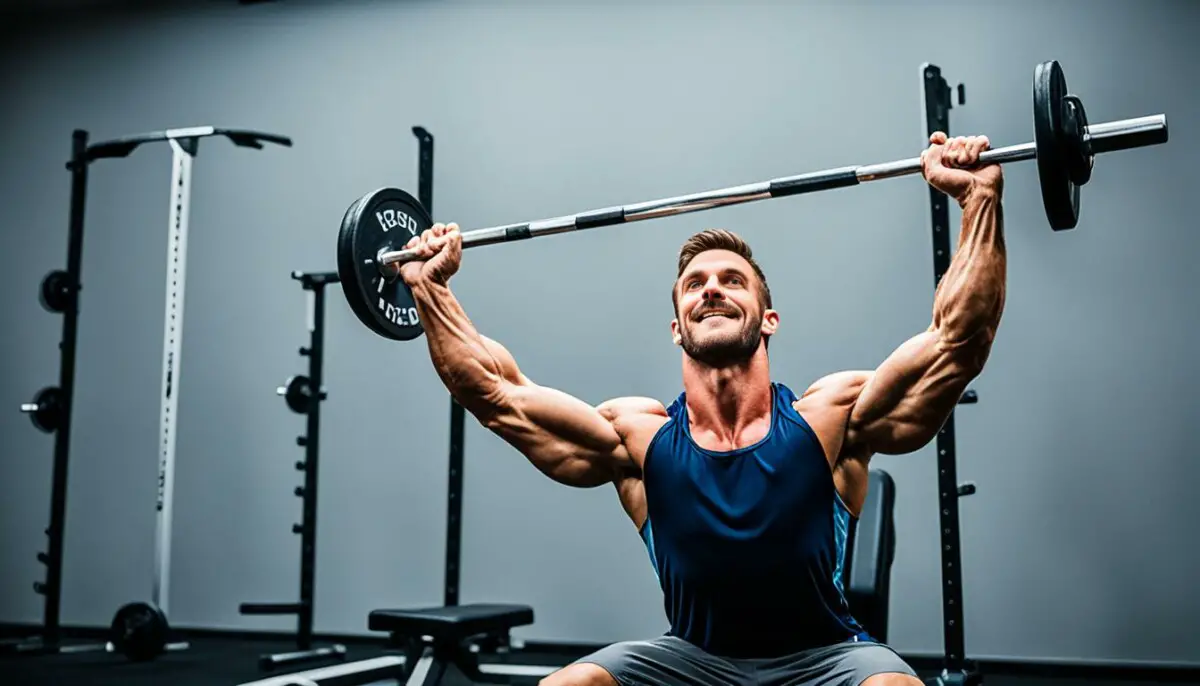Last Updated on 3 months by Francis
The seated barbell shoulder press is a compound exercise that targets the anterior and medial deltoids, with support from the triceps, upper chest, and traps. It is a variation of the overhead press and is used to build and strengthen the shoulder muscles. This exercise can be performed with either a barbell or dumbbells, and it is beneficial for beginners and advanced lifters alike.
Contents
Key Takeaways:
- The seated barbell shoulder press targets the shoulder muscles and is a compound exercise that works multiple muscle groups simultaneously.
- Proper form and posture, including a neutral spine and engaged core, are essential for performing the seated barbell shoulder press.
- The exercise can be modified with variations such as using dumbbells, adjusting grip width, and modifying the bench angle to target different areas of the shoulder muscles.
- Progression should be gradual, starting with lighter weights and gradually increasing as strength and technique improve.
- Individuals with shoulder issues or limited mobility should exercise caution and consult with a healthcare professional before attempting this exercise.
Target Muscles in Seated Barbell Shoulder Press
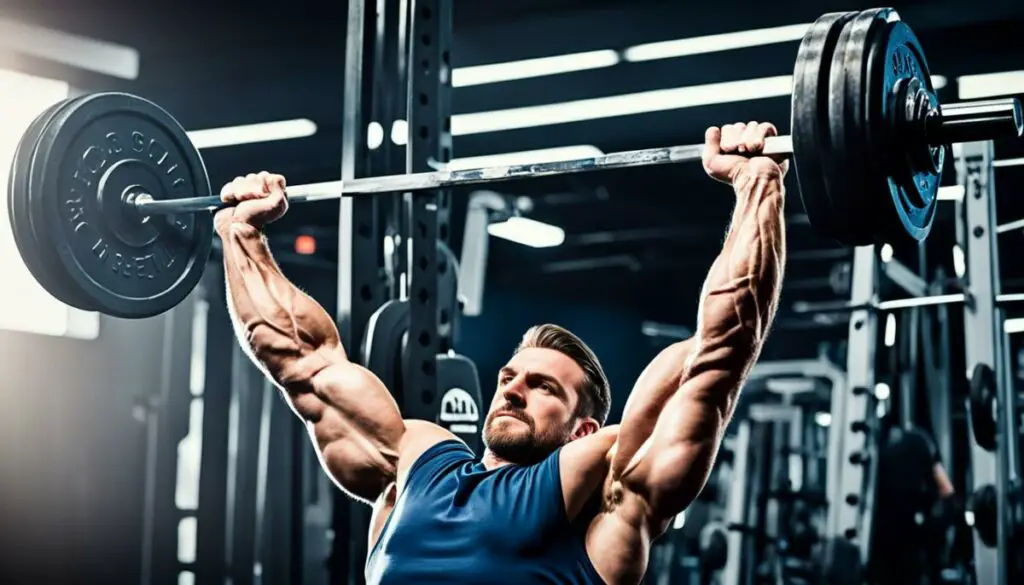
The seated barbell shoulder press is an effective compound exercise that targets multiple muscle groups in the upper body. Primarily, this exercise focuses on the shoulder muscles, specifically the anterior and medial deltoids. These are the main muscles responsible for raising the arms in front and to the sides, respectively. By performing the seated barbell shoulder press, you can effectively strengthen and develop these shoulder muscles, providing stability and functionality to your upper body movements.
In addition to the shoulder muscles, the seated barbell shoulder press also engages other muscle groups as secondary targets. The trapezius muscles, located in the upper back and neck region, are activated to support the movement and help stabilize the shoulders. The triceps, located at the back of the upper arm, also play a supporting role by assisting in arm extension during the exercise.
By engaging these multiple muscle groups, the seated barbell shoulder press provides a comprehensive upper body workout. It not only helps to build and strengthen the shoulder muscles but also contributes to overall upper body strength and stability.
Benefits of Targeted Muscles:
- Shoulder muscles (anterior and medial deltoids): Improved shoulder strength, stability, and muscle definition.
- Trapezius muscles: Increased upper back and neck strength, promoting better posture and shoulder stability.
- Triceps: Enhanced arm strength and definition, supporting the movement of the arms during the exercise.
Engaging multiple muscle groups in the upper body, the seated barbell shoulder press is an effective exercise for targeting the shoulder muscles, trapezius muscles, and triceps. By incorporating this compound exercise into your workout routine, you can develop strength, stability, and muscle definition in these key areas.
Exercise Description – Seated Barbell Shoulder Press
The seated barbell shoulder press is a highly effective exercise for targeting the shoulder muscles while seated in a comfortable position. It is performed using a barbell and can be incorporated into various workout routines, including shoulder-focused workouts, push workouts, and full-body workouts. This exercise allows for maximum engagement of the shoulder muscles and can be adjusted according to different fitness levels and goals.
To perform the seated barbell shoulder press:
- Sit on a bench with your back straight and feet flat on the ground.
- Hold a barbell with an overhand grip, palms facing forward.
- Position the barbell at shoulder level, slightly in front of your head.
- Inhale and press the barbell upward, extending your arms fully overhead.
- Pause briefly at the top of the movement, engaging your shoulder muscles.
- Exhale and lower the barbell back to the starting position.
- Repeat the exercise for the desired number of repetitions.
The seated barbell shoulder press primarily targets the shoulder muscles, specifically the anterior and medial deltoids. It also engages the trapezius muscles and the triceps as secondary muscles.
This exercise is beneficial for individuals of all fitness levels as it allows for controlled and targeted movements, reducing the risk of injury. It can help improve shoulder strength, muscle definition, and overall upper body stability.
When incorporating the seated barbell shoulder press into your workout routine, it is important to start with a weight that you can comfortably lift with proper form. Gradually increase the weight as you gain strength and confidence. Additionally, ensure that you warm up your shoulder muscles before performing this exercise to prevent injury and enhance performance.
Note: If you are new to the seated barbell shoulder press or have any pre-existing shoulder issues, it is recommended to consult with a fitness professional or healthcare provider for guidance on proper form and modifications.
By including the seated barbell shoulder press in your workouts, you can target and strengthen your shoulder muscles effectively while enjoying the benefits of a seated position, allowing for more controlled and focused movements.
Proper Form for Seated Barbell Shoulder Press

Executing the seated barbell shoulder press with the correct technique is crucial to maximize its effectiveness and reduce the risk of injury. Follow these guidelines to maintain proper form throughout the exercise.
Sitting Position and Posture
Begin by sitting on a bench with proper posture. Keep your back straight and maintain a neutral spine throughout the movement. This helps to ensure that the load is evenly distributed and prevents unnecessary strain on the back.
Foot Placement
Position your feet flat on the ground, slightly wider than shoulder-width apart. This provides a stable base and helps to establish balance and control during the exercise.
Grip
Grasp the barbell with an overhand grip, placing your hands slightly wider than shoulder-width apart. Your palms should be facing forward, with the wrists in line with your forearms. This grip promotes optimal engagement of the shoulder muscles and helps to maintain stability.
Shoulder Position
Throughout the movement, focus on keeping your shoulders pinned down and retracted. Avoid allowing the shoulders to hunch or shrug upward. This helps to activate the targeted shoulder muscles and prevents undue stress on the neck and upper traps.
Core Engagement
Engage your core muscles by drawing your belly button towards your spine. This provides stability and support for your spine throughout the exercise. Maintaining a strong core also helps to prevent excessive strain on the lower back.
Arm Extension
As you press the barbell overhead, fully extend your arms while maintaining control. This ensures that the shoulder muscles are fully engaged and fully benefit from the exercise. Avoid locking out the elbows at the top of the movement to avoid putting excessive stress on the joint.
Lowering the Barbell
When lowering the barbell back to the starting position, focus on controlling the descent. This eccentric phase of the movement provides an opportunity for muscle growth and should not be rushed. Keep the movement smooth and controlled throughout.
By following these guidelines and maintaining proper form, you can safely and effectively perform the seated barbell shoulder press, optimizing its benefits and minimizing the risk of injury.
Benefits of Seated Barbell Shoulder Press

The seated barbell shoulder press provides a range of benefits that contribute to overall upper body strength and shoulder development. Here are some of the key advantages of incorporating this exercise into your fitness routine:
- Targeted Muscle Growth: The seated barbell shoulder press specifically targets the anterior and medial deltoids, which are the main muscles responsible for shoulder strength and stability. By consistently performing this exercise, you can effectively build and sculpt these muscles, resulting in increased size and definition.
- Improved Shoulder Stability: As a compound exercise, the seated barbell shoulder press engages multiple muscle groups simultaneously, including the shoulder muscles, triceps, and upper chest. This coordinated effort helps to enhance shoulder stability, reducing the risk of potential injuries and promoting better posture.
- Increase in Upper Body Strength: The seated barbell shoulder press is a challenging exercise that requires significant upper body strength to execute. By regularly incorporating this movement into your workouts, you can progressively increase the weight lifted, leading to improved strength and overall performance in other upper body exercises.
- Efficient Muscle Targeting: The seated position while performing the barbell shoulder press minimizes the need for stability, allowing you to focus primarily on targeting and isolating the shoulder muscles. This controlled movement improves muscle engagement and ensures maximum effectiveness in each repetition.
The seated barbell shoulder press offers versatility and scalability to suit individuals of all fitness levels and goals. Whether you aim to build muscle mass, improve shoulder strength, or enhance overall upper body definition, this exercise provides valuable benefits that can contribute to your fitness journey.
See the table below for a quick overview of the benefits of the seated barbell shoulder press:
| Benefits of Seated Barbell Shoulder Press |
|---|
| Targeted muscle growth in the anterior and medial deltoids. |
| Improved shoulder stability and reduced risk of injuries. |
| Increase in upper body strength and performance. |
| Efficient targeting and isolation of the shoulder muscles. |
Seated Barbell Shoulder Press Variations
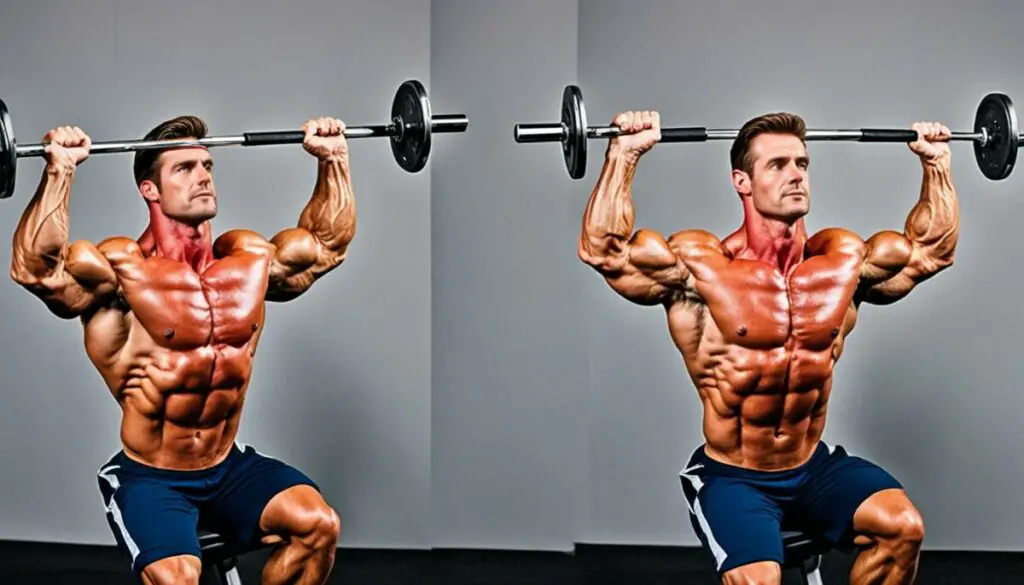
Take your seated barbell shoulder press to the next level by incorporating different variations into your workouts. These variations not only add variety to your training routine but also target different areas of the shoulder muscles for a well-rounded workout.
1. Dumbbell Seated Shoulder Press: Instead of using a barbell, try using dumbbells for your seated shoulder press. This variation allows for a greater range of motion and provides better stability for each arm independently. Hold a dumbbell in each hand with palms facing forward and press them overhead, fully extending your arms. Lower the dumbbells back down to shoulder level and repeat.
2. Grip Width Adjustment: Experiment with different grip widths during your seated barbell shoulder press to engage different parts of the shoulder muscles. A wider grip targets the outer delts, while a narrower grip places more emphasis on the inner delts. Find the grip width that feels comfortable and challenging for your specific goals.
3. Incline or Decline Bench: Modifying the angle of the bench can also change the focus of the seated barbell shoulder press. Performing the exercise on an incline bench targets the front delts more, while using a decline bench shifts the focus to the rear delts. Adjust the bench angle according to your desired muscle activation.
Tips for Incorporating Variations:
- Start with lighter weights and focus on maintaining proper form before progressing to heavier weights.
- Include a variety of variations in your shoulder workouts to continually challenge your muscles and prevent plateaus.
- Listen to your body and adjust the variations based on your individual strengths, weaknesses, and any pre-existing shoulder issues.
- Consult with a fitness professional if you need guidance on selecting the appropriate variations for your fitness level and goals.
By incorporating these seated barbell shoulder press variations into your workouts, you can target different areas of the shoulder muscles and keep your training routine exciting and effective.
Tips for Seated Barbell Shoulder Press
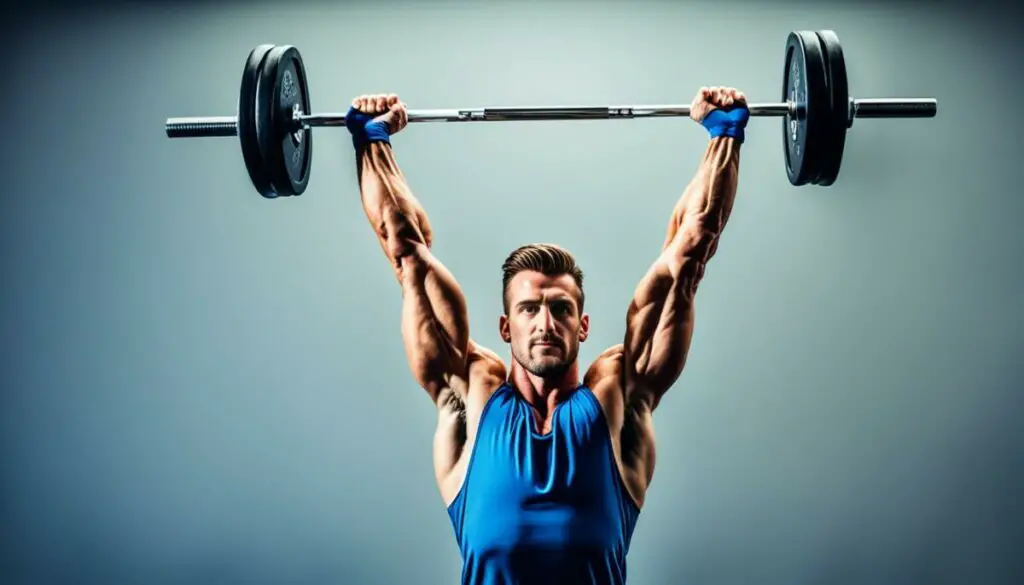
Here are some tips to help you optimize your seated barbell shoulder press:
- Focus on proper form: Maintain a neutral spine and sit upright with your feet flat on the ground. Keep your shoulders pinned down and engage your core for stability throughout the exercise.
- Choose the appropriate weight: Start with a weight that allows you to complete the exercise with proper form and technique. Gradually increase the weight as your strength and stability improve.
- Control the movement: Avoid using momentum or jerking motions to lift the barbell. Lift the weight with controlled and smooth movements to maximize muscle engagement.
- Vary grip width: Experiment with different grip widths to target different areas of the shoulder muscles. A wider grip may emphasize the medial deltoids, while a narrower grip may target the anterior deltoids.
- Incorporate pauses: At the top of the movement, pause for a brief moment to fully contract the shoulder muscles. This can enhance muscle activation and strength gains.
- Breathe properly: Inhale as you lower the barbell and exhale as you press it up. Coordinate your breath with the movement to maintain proper form and oxygenate your muscles.
By following these tips, you can enhance the effectiveness of your seated barbell shoulder press and achieve optimal results.
Seated Barbell Shoulder Press vs. Standing Overhead Press

The seated barbell shoulder press and the standing overhead press are both effective exercises for targeting the shoulder muscles. However, they have some key differences that can impact muscle activation and overall workout experience.
One advantage of the seated barbell shoulder press is that it reduces the need for stability compared to the standing overhead press. By sitting on a bench, you can focus more on isolating and targeting the shoulder muscles, specifically the anterior and medial deltoids. This exercise allows for a more controlled movement and can be beneficial for individuals who struggle with balance or have limited stability.
Another benefit of the seated position is that it provides support for the back, which can be advantageous for individuals with lower back issues. Sitting on a bench helps maintain proper spinal alignment throughout the exercise, reducing the risk of strain or injury to the lower back.
On the other hand, the standing overhead press requires more core engagement and can activate additional muscle groups such as the glutes and lower back. This exercise involves standing upright and pressing the barbell or weights overhead, utilizing the entire body to stabilize and lift the weight. The standing overhead press can provide a full-body workout experience, engaging multiple muscle groups simultaneously.
When choosing between the seated barbell shoulder press and the standing overhead press, consider your specific goals, fitness level, and any physical limitations. If you are looking to isolate and target the shoulder muscles with less emphasis on stability, the seated barbell shoulder press may be a better option. However, if you want to engage multiple muscle groups and challenge your core strength, the standing overhead press can provide a more dynamic and comprehensive workout.
Overall, both exercises have their merits and can be incorporated into your training routine based on individual preferences and goals. Experiment with both variations to find the one that aligns best with your fitness journey and provides the desired results.
Seated Barbell Shoulder Press Safety Considerations
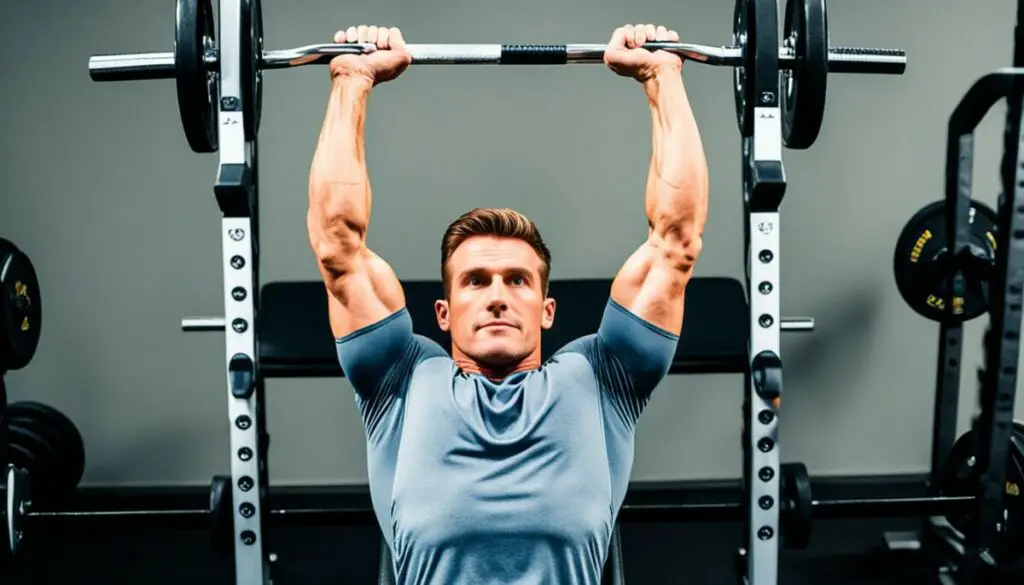
While the seated barbell shoulder press is a highly effective exercise for targeting the shoulder muscles, it is important to consider certain safety considerations, especially for individuals with shoulder issues or a lack of mobility. Taking precautions and consulting with a healthcare professional can help prevent potential injuries and ensure a safe and effective workout.
Here are some important safety tips to keep in mind:
- Consult with a healthcare professional: If you have any pre-existing shoulder issues or concerns about your mobility, it is crucial to consult with a healthcare professional before incorporating the seated barbell shoulder press into your workout routine. They can provide personalized advice and modifications based on your specific needs.
- Practice proper form: Maintaining proper form during the seated barbell shoulder press is essential for preventing injuries. Focus on keeping your back straight, shoulders pinned down, and core engaged throughout the movement. A neutral spine and correct grip can help distribute the load evenly and reduce the risk of strain.
- Start with lighter weights: When starting out or returning to the seated barbell shoulder press after a break, begin with lighter weights to allow your muscles and joints to adapt to the exercise. Gradually increase the weight as your strength and technique improve.
- Warm up adequately: Prior to performing the seated barbell shoulder press, warm up your shoulder muscles with dynamic stretching and mobility exercises. This helps increase blood flow, improve range of motion, and reduce the risk of injury.
- Progress gradually: Avoid the temptation to lift heavy weights or increase the intensity too quickly. Progress gradually by gradually increasing the resistance or number of repetitions over time. This approach allows your muscles to adapt and minimizes the risk of overtraining or overloading your shoulders.
By implementing these safety considerations and following proper form, individuals with shoulder issues or lack of mobility can still benefit from the seated barbell shoulder press while minimizing the risk of injury or discomfort.
“Safety first: Consult with a healthcare professional if you have any shoulder issues or lack of mobility.”
Incorporating Seated Barbell Shoulder Press into Your Routine
The seated barbell shoulder press is a versatile exercise that can be easily incorporated into your workout routine. Whether you’re looking to target your shoulder muscles, focus on push workouts, or engage in full-body workouts, the seated barbell shoulder press can be a valuable addition to your training regimen.
Shoulder-Focused Workouts
Incorporating the seated barbell shoulder press into your shoulder-focused workouts is an excellent way to specifically target the shoulder muscles. This exercise engages the anterior and medial deltoids, providing an effective way to build strength and size in these areas. By adding variations such as adjusting grip width or bench angle, you can further enhance the effectiveness of your shoulder-focused workouts.
Push Workouts
The seated barbell shoulder press is a perfect addition to push workouts, which involve exercises that target the upper body pushing muscles. In combination with exercises such as bench press and push-ups, the seated barbell shoulder press helps to develop overall upper body strength and power. It also contributes to improved shoulder stability, which is crucial for various push movements.
Full-Body Workouts
If you’re looking for a compound exercise that works multiple muscle groups simultaneously, the seated barbell shoulder press is an ideal choice for full-body workouts. This exercise engages not only the shoulder muscles but also the triceps, upper chest, and traps. By incorporating the seated barbell shoulder press into your full-body workouts, you can maximize your training efficiency and target a wide range of muscles in a single exercise.
To ensure proper form and maximize the benefits of the seated barbell shoulder press, start with lighter weights and gradually increase as your strength improves. Remember to warm up your shoulder muscles before performing this exercise and practice proper technique to avoid injury.
With its versatility and ability to target multiple muscle groups, the seated barbell shoulder press is a valuable exercise that can elevate your training routine. Incorporate it into your workouts to enhance shoulder strength, improve overall upper body pushing power, or engage in full-body workouts for a total-body training experience.
| Benefits of Incorporating Seated Barbell Shoulder Press |
|---|
| Targets shoulder muscles |
| Engages upper body pushing muscles |
| Works multiple muscle groups simultaneously |
| Improves shoulder stability |
| Enhances overall upper body strength |
Importance of Proper Warm-up and Progression
Before performing the seated barbell shoulder press, it is crucial to properly warm up the shoulder muscles and prepare them for the exercise. Warm-up routines increase blood circulation, enhance muscle flexibility, and reduce the risk of injury. A combination of dynamic stretching, mobility exercises, and light weight warm-up sets can effectively warm up the muscles and joints, ensuring optimal performance during the seated barbell shoulder press.
Incorporating dynamic stretching exercises such as arm circles, shoulder rolls, and cross-body arm swings helps to loosen up the shoulder muscles and improve range of motion. These movements increase blood flow and activate the muscles, making them more responsive during the subsequent exercise.
Additionally, mobility exercises like shoulder dislocations and shoulder rotations with a resistance band help to improve shoulder mobility and flexibility. These exercises target the specific joint movements involved in the seated barbell shoulder press, allowing for a full range of motion and reducing the risk of strain or injury.
Quote:
A proper warm-up primes your body for the seated barbell shoulder press, allowing you to perform the exercise more effectively and safely. Don’t rush into heavy lifting without properly preparing your shoulder muscles.
Progression is another important aspect of any strength training program, including the seated barbell shoulder press. Gradually increasing the weight and intensity of your workouts helps to build strength and avoid plateaus. When starting out, use lighter weights that allow you to maintain proper form and technique. As you gain strength and confidence, gradually increase the weight to challenge your muscles and stimulate further growth.
Progression Example:
| Training Phase | Reps | Sets | Weight |
|---|---|---|---|
| Beginner | 8-10 | 3 | 50 lbs |
| Intermediate | 6-8 | 4 | 70 lbs |
| Advanced | 4-6 | 5 | 90 lbs |
Remember, proper warm-up and progression are essential for optimizing your seated barbell shoulder press workouts. Prioritize injury prevention and gradual increases in intensity to achieve the best results from your training.
Conclusion
The seated barbell shoulder press is a highly effective exercise for targeting the shoulder muscles and achieving overall upper body strength. With its versatility and ability to be modified, this exercise can be tailored to meet the needs of individuals at different fitness levels and with varied goals.
Proper form is essential when performing the seated barbell shoulder press. Maintaining a neutral spine, engaging the core, and keeping the shoulders pinned down are crucial for maximizing the benefits and minimizing the risk of injury.
Furthermore, warming up the shoulder muscles before starting the exercise and gradually increasing the weight load are essential for a safe and effective workout. Whether you are a beginner looking to build strength and stability or an advanced lifter seeking to improve muscle definition and performance, incorporating the seated barbell shoulder press into your routine can yield impressive results.
In conclusion, the seated barbell shoulder press is a versatile exercise that targets the shoulder muscles, enhances upper body strength, and provides various benefits. By following proper form, warm-up techniques, and progression strategies, you can ensure a safe and effective workout. Take advantage of this compound exercise to achieve your fitness goals and elevate your shoulder training to new heights.
FAQ
What muscles does the seated barbell shoulder press target?
The seated barbell shoulder press primarily targets the anterior and medial deltoids, with support from the triceps, upper chest, and traps.
How do you perform the seated barbell shoulder press?
To perform the seated barbell shoulder press, sit on a bench with a barbell in your hands, palms facing forward. Press the barbell above your head, fully extending your arms, and then lower it back to the starting position.
What is the proper form for the seated barbell shoulder press?
To maintain proper form during the seated barbell shoulder press, sit with proper posture, grip the barbell with palms facing forward, keep your shoulders pinned down, maintain a neutral spine, and fully extend your arms overhead.
What are the benefits of the seated barbell shoulder press?
The seated barbell shoulder press helps to strengthen and build muscle in the shoulder muscles, improves shoulder stability, increases upper body strength, and allows for more efficient muscle targeting due to the seated position.
Are there any variations of the seated barbell shoulder press?
Yes, variations of the seated barbell shoulder press include using dumbbells instead of a barbell, adjusting grip width, and modifying the bench angle to target different areas of the shoulder muscles.
What are some tips for performing the seated barbell shoulder press?
Tips for the seated barbell shoulder press include starting with lighter weights and gradually progressing, focusing on proper form and posture, engaging the core for stability, and incorporating warm-up exercises for the shoulder muscles.
How does the seated barbell shoulder press compare to the standing overhead press?
The seated barbell shoulder press reduces the need for stability and provides back support, while the standing overhead press requires more core engagement and can activate additional muscle groups like the glutes and lower back.
Are there any safety considerations for the seated barbell shoulder press?
Individuals with shoulder issues or a lack of mobility should approach the seated barbell shoulder press with caution or consult with a healthcare professional. It is important to practice proper form, start with lighter weights, and progress gradually to avoid injury.
How can I incorporate the seated barbell shoulder press into my workout routine?
The seated barbell shoulder press can be included in shoulder-focused workouts, push workouts, and full-body workouts. It is a versatile exercise that targets multiple muscle groups simultaneously and can be adjusted to suit different fitness levels and goals.
Why is proper warm-up and progression important for the seated barbell shoulder press?
Warming up the shoulder muscles and gradually progressing in weight are important to prepare the muscles for the exercise and avoid overloading them, reducing the risk of injury. Start with lighter weights and increase gradually as strength and technique improve.

